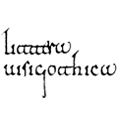Teaching Palaeography III: new experiences
Once in a while, I have a student who wants to know more about Early Medieval Palaeography just for the sake of knowledge and gladly undertakes specially designed training on the topic. What follows are my and his thoughts on the experience.
TEACHING VISIGOTHIC SCRIPT
It is quite comforting to know that, although Palaeography as a field is not going through its best moment in Spain – particularly Early Medieval Palaeography –, there are still students out there who care to know more about it. From my personal point of view, it is at the same time disheartening to hear them talk about their previous experience with Palaeography when we first meet.
First of all, (my) Visigothic script is usually not taught with the excuse there are very few manuscripts (sure, only some 400 codices and several thousand charters) and everything has been already studied (come on! Nothing is always completely studied, keep your enthusiasm alive). Dear colleagues, with all due respect, you have a responsibility towards your field and your students, please be consistent. I might not teach my students Merovingian script for them to master it, but at least I tell them it exists and show them how it looks like and why is it important framed on its historical and cultural context.
Second, students have no idea whatsoever of what does it mean “to do Palaeography”, or to be a specialist in Manuscript Studies for that matter. Every single one of the students I have had contact with had repeated like a creed “a palaeographer’s work is to put medieval documents in “”a normal typography”” for historians to read”. OMG. Please, ours is the responsibility to change that. I am for launching a global media campaign to all public…
Long story short, please do encourage students to learn about manuscripts. Palaeography needs you – by the way, this includes Codicology, Diplomatics, Semiology, History of writing… Manuscript Studies aka Historiographical Sciences and Techniques (in Spanish jargon).
LEARNING VISIGOTHIC SCRIPT
“Along these lines, I will try to explain how was my first experience studying Visigothic script Palaeography.
A few months ago, I started learning Palaeography with Ainoa. I remember the first time I saw a document written in Visigothic script; I had never seen this type of writing before and I panicked. I had studied Palaeography during my degree in History at University three years ago, although just for a short period, and I had seen manuscripts written in Gothic script, but this was something different. When studying Medieval Palaeography at university, especially in the south of Spain, teachers do not usually teach Visigothic script saying that there are few manuscripts written in this script compared with plenty of documents in Gothic or other scripts. On the other hand, I have to say that, when I finished my degree, I thought the job of a medieval palaeographer consisted on transcribing documents, and also that the most important part of manuscripts was their content. But after studying Visigothic script Palaeography, I have learnt Palaeography offers many different possibilities to study the Middle Ages, especially from the 8th to the 12th centuries.
I have learnt many things which are essential. For example that, by looking at a manuscript, a trained palaeographer is able to know the type of monastery where it was written, the places where the manuscript had been through its life, or even if the scribe was able to read or, conversely, if he just knew to write and copy texts (among other things). In my opinion, this type of information is really important and useful to understand society or culture in the early Middle Ages.
I must recognise that the first time I saw an example of Visigothic script I thought I would never be able to read it, but, even slowly, I can now read and understand the documents.
To conclude, I have to say that I am still studying Visigothic and Caroline scripts, and I hope to keep learning because I think Palaeography is fascinating.”
•tweet it
by A. Castro and J. Gómez

